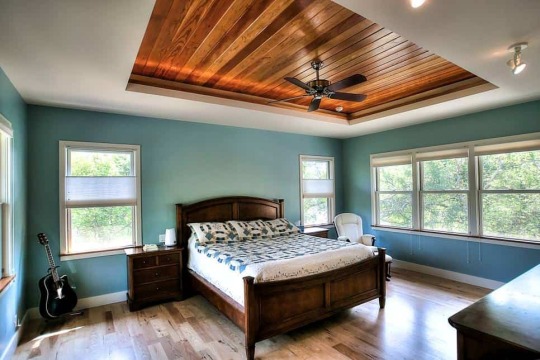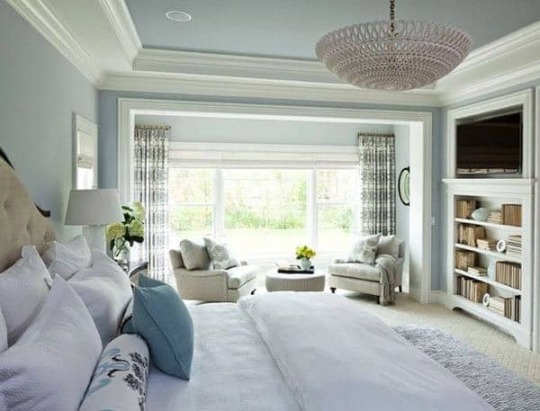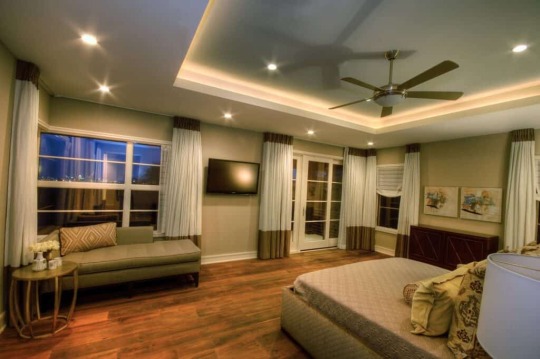#tradeceiling
Text
Tray Ceilings: Types, Materials, and Benefits

A tray ceiling, also known as a recessed or inverted ceiling, is an architectural feature that creates the illusion of depth and height in a room by having a central recessed area surrounded by a higher outer border.
Tray ceilings are designed to create a visual illusion of depth and height, making a room appear more spacious and elegant. These types of ceilings can be found in a variety of settings, from residential homes to commercial buildings such as restaurants, hotels, and office spaces.
Tray ceilings offer a versatile design element that can be customized to fit any interior design style, from classic to contemporary. In this article, we will explore the various types of tray ceilings, materials used in their construction, design ideas, installation process, and benefits.
Importance of Tray Ceilings in interior design
Tray ceilings are an important architectural feature in interior design as they provide a range of benefits that enhance the overall look and feel of a room. One of the primary advantages of tray ceilings is that they create the illusion of height and depth, making a room appear more spacious and elegant.
They also offer a versatile design element that can be customized to fit any interior design style, from classic to contemporary. Tray ceilings can be used to draw attention to a specific area of a room, such as a dining area or a focal point like a fireplace or artwork.
They can also be used to provide a space for lighting fixtures, such as recessed lighting or pendant lights, which can create a warm and inviting ambiance.
Read More: What Is A Coffered Ceiling | Top 3 Types of Coffered Ceiling | Styles of Coffered Ceiling
Types of Tray Ceilings
Tray ceilings are a popular architectural feature in modern interior design that can add a touch of elegance and sophistication to any space. There are various types of tray ceilings, each with its unique design and construction method. In this article, we will explore the different types of tray ceilings to help you determine which one is best for your home or commercial space.
1. Single Tray Ceiling

A single tray ceiling is the most basic type of tray ceiling, consisting of a single level of recessed area surrounded by a higher outer border. It is simple in design, making it a popular choice for homeowners who want to add a touch of elegance to their space without being too elaborate.
2. Double Tray Ceiling

A double tray ceiling is a more elaborate version of the single tray ceiling, with two or more levels of recessed areas. This type of tray ceiling adds depth and dimension to a room, making it appear more spacious and luxurious.
3. Coffered Tray Ceiling

A coffered tray ceiling features a grid of recessed panels, typically in a square or rectangular pattern. It is an intricate design that adds a classic and elegant touch to a space.
4. Recessed Tray Ceiling

A recessed tray ceiling is similar to a single tray ceiling, but instead of having a raised border, the ceiling is flush with the walls. This type of tray ceiling is ideal for creating a clean and modern look in a space.
Read More: 50 False Ceiling Designs | False Ceiling Designs for Hall | False Ceiling Designs for Bedroom
Materials Used for Tray Ceilings
There are several materials used in constructing tray ceilings, including gypsum board, wood, metal, plaster, and fiberboard. Gypsum board is a common material due to its affordability and versatility, while wood and metal are popular choices for creating a luxurious look.
Plaster offers a more traditional and classic appearance, while fiberboard provides a lightweight and cost-effective option. The material you choose will depend on your budget, desired aesthetic, and the overall design of the room. Additionally, different materials may require different installation methods and maintenance requirements, so it's essential to choose the right material for your specific needs.
- Gypsum board
- Wood
- Metal
- Plaster
- Fiberboard
Advantages of Tray ceilings
Increase Height: Generally tray ceiling help to increase the height and space of the room due to their additional depth in the central portion.
Enhancing the beauty of the Room: A tray ceiling enhances the overall beauty of the room and gives a rich, luxurious touch to your house or open space.
Adds Value: It permits more natural light and air into the house so which adds more value.
Offer installation of more light: This ceiling offers special light such as LED lights, accent lights, and recessed Light, which gives an ambiance look to your living space.
Give more flexibility to decorate the ceiling: According to your taste easily paint with different colors, and décor, add lights, mold a border, and style.
Disadvantages of Tray Ceiling
A little bit expensive as compared to other types of ceilings: Tray ceilings required additional labor charge and material charge so they it is more expensive than other types of ceilings.
Difficult to maintain or clean: In this type of ceiling recessed part of the ceiling can be difficult to maintain and clean.
Look like a dated: if the Tray ceiling cannot be placed properly then looks like a dated version, other hand makes sure before installing a ceiling in an older house this is compatible with the present interior of the house.
Read More: 8 Types of False Ceiling for Home
Conclusion
In conclusion, tray ceilings are a popular architectural feature in modern interior design that offer a range of benefits, from creating the illusion of height and depth to providing a versatile design element that can be customized to fit any style. There are various types of tray ceilings, each with its unique design and construction method, and a wide range of materials that can be used to construct them.
Whether you opt for a simple single tray ceiling or an elaborate coffered tray ceiling, tray ceilings can add a touch of elegance and sophistication to any space. So, if you're looking to enhance the beauty and functionality of your home or commercial space, consider incorporating tray ceilings into your design plans.
FAQs:
What is a tray ceiling? A tray ceiling is an architectural feature that creates the illusion of depth and height in a room by having a central recessed area surrounded by a higher outer border.What materials are used to construct tray ceilings?Tray ceilings can be constructed from various materials, such as gypsum board, wood, metal, plaster, or fiberboard, depending on the desired aesthetic and budget.What are the benefits of tray ceilings?Tray ceilings can add visual interest and architectural detail to a space, create the illusion of height and depth, and provide a versatile design element that can be customized with lighting fixtures, crown molding, or other decorative elements.
What types of tray ceilings are there?The most common types of tray ceilings include single tray ceilings, double tray ceilings, coffered tray ceilings, and recessed tray ceilings.
You May Also Like:
- What Is A Coffered Ceiling | Top 3 Types of Coffered Ceiling | Styles of Coffered Ceiling
- 50 False Ceiling Design | False Ceiling Design for Hall | False Ceiling Design for Bedroom | False Ceiling For Hotels & Restaurants
- 8 Types of False Ceiling for Home
- How Tall Are Ceilings | Typical Ceiling Heights | Standard Height of Residential Building
- Water Leaking From Ceiling | How to Stop Water Leakage From Ceiling | Ceiling Leak
- How To Waterproof Basement | Waterproofing Basement Walls From Inside | Top 4 Best Basement Waterproofing Methods
- Signs of Water Damage In House | Signs of water damage In Walls
Read the full article
#addingatrayceiling#fauxtrayceiling#reversetrayceiling#tieredceiling#tradeceiling#trayceiling#trayceilingdesign#trayceilingideas#trayceilingina8footroom#trayceilings#trayedceilingframing#treyceiling#treyceilingframing#treyceilings#typesoftrayceilings#whatisatrayceiling
0 notes